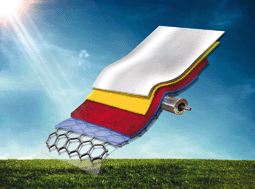Solution processed reduced graphene oxide electrodes for organic photovoltaics
Abstract
Since the isolation of free standing graphene in 2004, graphene research has experienced a phenomenal growth. Due to its exceptional electronic, optical and mechanical properties, graphene is believed to be the next wonder material for optoelectronics. The enhanced electrical conductivity, combined with its high transparency in the visible and near-infrared regions of the spectrum, enabled graphene to be an ideal low cost indium-tin oxide (ITO) substitute. Solution-processed reduced graphene oxide combines the unique optoelectrical properties of graphene with large area deposition and flexible substrates rendering it compatible with roll-to-roll manufacturing methods. This paper provides an overview of recent research progress in the application and consequent physical–chemical properties of solution-processed reduced graphene oxide-based films as transparent conductive electrodes (TCEs) in organic photovoltaic (OPV) cells. Reduced graphene oxide (rGO) can be effectively utilized as the TCE in flexible OPVs, where the brittle and expensive ITO is incompatible. The prospects and future research trends in graphene-based TCEs are also discussed.



 Please wait while we load your content...
Please wait while we load your content...